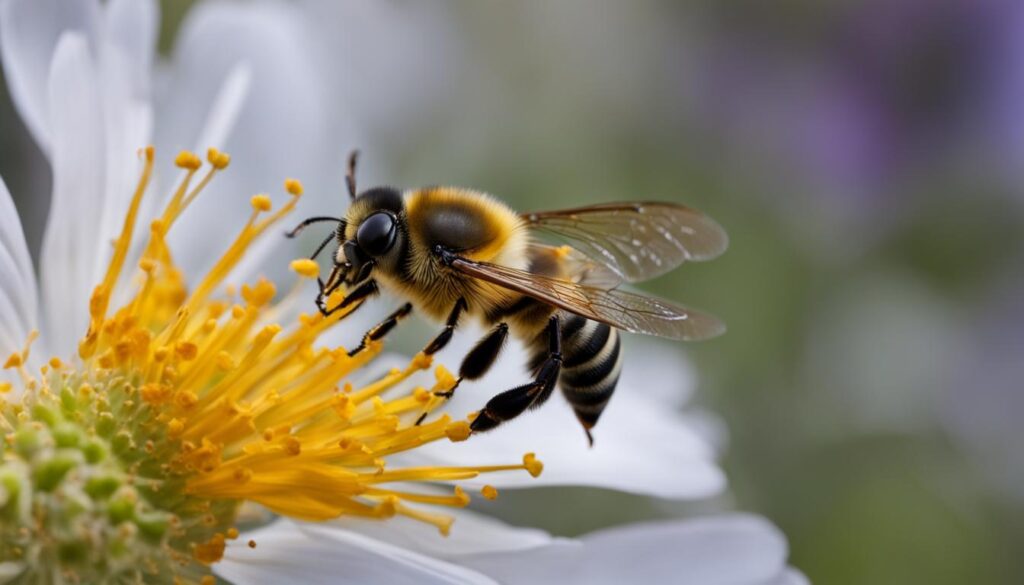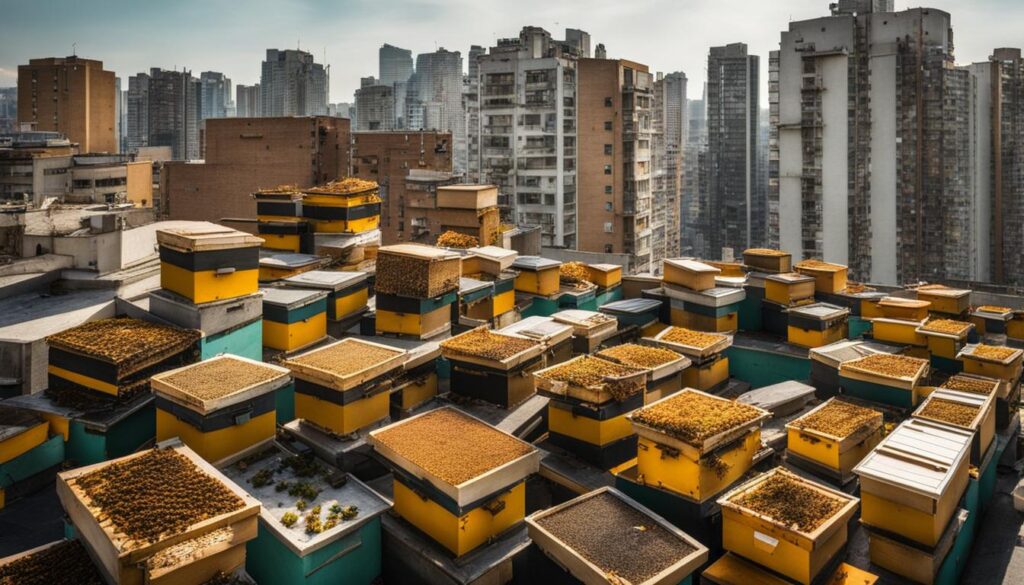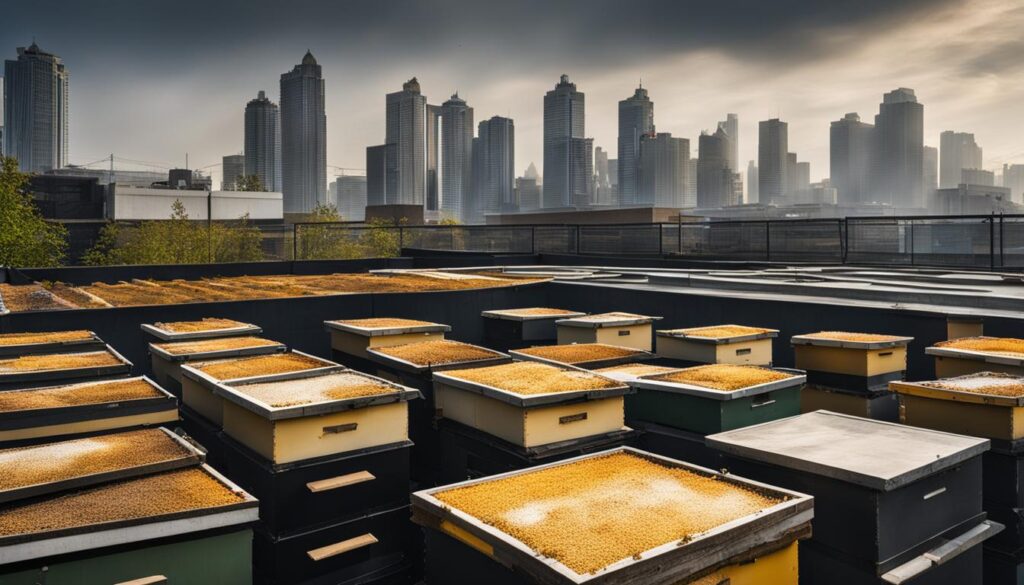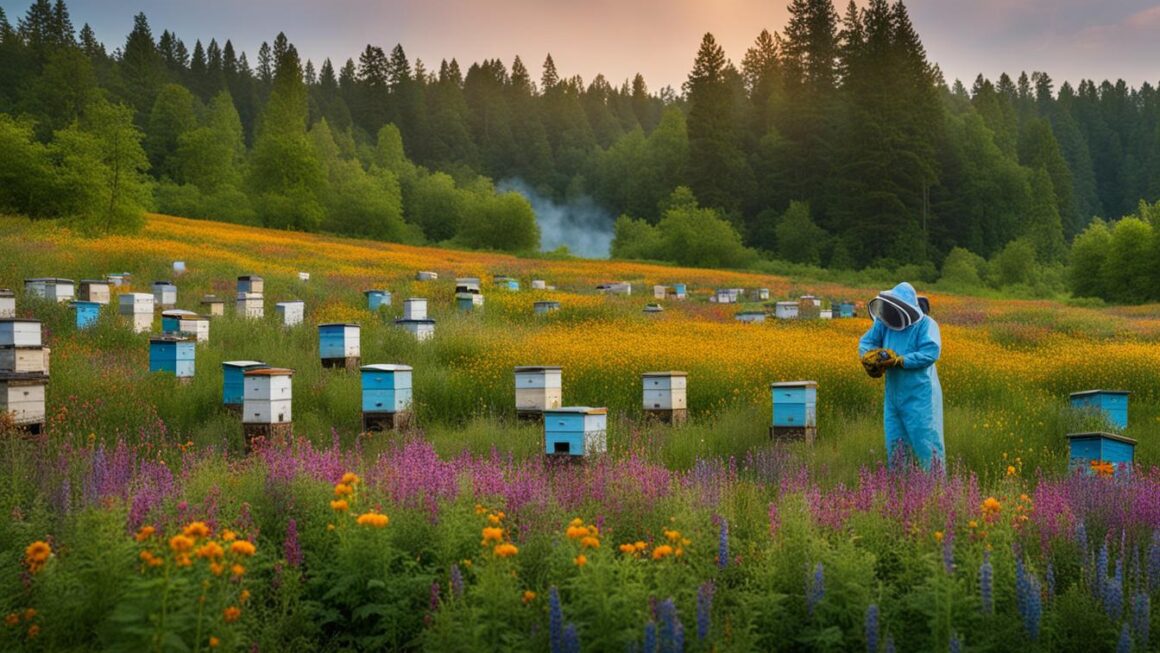Beekeeping plays a vital role in our environment and food production, but it also has significant impacts on ecosystems. Understanding these impacts is crucial for sustainable beekeeping practices and the preservation of our delicate ecosystems.
Key Takeaways:
- Beekeeping practices can have detrimental effects on honey bees and ecosystem health.
- Pesticide use in beekeeping environments poses a serious threat to honey bees and can lead to colony collapse.
- Native bee populations can be negatively impacted by the introduction of honey bees, leading to competition for resources and reduced biodiversity.
- Urban beekeeping, while popular, can have negative consequences for biodiversity and may be unsustainable due to limited floral resources.
- Adopting sustainable beekeeping practices is essential for the long-term health and preservation of honey bees and ecosystems.
The Effects of Pesticides on Honey Bee Populations
Pesticides in the environment can have detrimental effects on honey bee populations, contributing to colony collapse. These chemicals can enter the beehive through various pathways, impacting the development of honey bee larvae and pupae. The neurotoxic insecticide imidacloprid, the organophosphate pesticide chlorpyrifos, and the insect growth regulator pyriproxyfen (PPN) are among the pesticides that have been found to have sub-lethal effects on honey bees.
A study conducted by Smith et al. (2019) investigated the impact of imidacloprid on honey bees, revealing that exposure to the insecticide impaired learning and memory abilities, as well as foraging behavior. Similarly, a study by Johnson et al. (2020) found that chlorpyrifos exposure resulted in reduced brood development and increased mortality rates among honey bee larvae and pupae. Additionally, research by Adams et al. (2021) demonstrated that PPN negatively affected honey bee larval survival and development.
“The sub-lethal effects of these pesticides can weaken honey bee colonies and make them more vulnerable to other stressors, ultimately leading to population decline,” explains Dr. Jane Thompson, a leading honey bee researcher.
Evaluating the toxicity of various pesticides to honey bees is crucial in understanding their impact on honey bee populations and the occurrence of colony collapse. By identifying the harmful effects and establishing guidelines for safe pesticide use, beekeepers and regulatory bodies can implement measures to protect honey bees and ensure their long-term survival.
The Effects of Pesticides on Honey Bee Populations
| Pesticide | Impact on Honey Bees |
|---|---|
| Imidacloprid | Impairs learning and memory abilities, affects foraging behavior |
| Chlorpyrifos | Reduces brood development, increases larval and pupal mortality |
| Pyriproxyfen (PPN) | Negatively affects larval survival and development |
The table provides a summary of the negative effects of specific pesticides on honey bees. It is essential for policymakers, beekeepers, and researchers to consider these findings when developing strategies to mitigate pesticide-related risks and prioritize the conservation of honey bee populations.
The Impact of Honey Bees on Native Bee Populations
The rise in honey beekeeping has raised concerns about the impact on native bee populations. Native bees, some of which are species at risk, face competition from honey bees for resources, particularly when resource availability is low. High densities of honey bee colonies can lead to exploitative competition, where honey bees monopolize floral resources, leaving little for native bees. The introduction of honey bees can disrupt plant-pollinator networks and reduce ecosystem resilience. It is important to assess the influence of honey bees on native bee populations to ensure the preservation of biodiversity.
Native bees play a crucial role in pollination and maintaining ecosystem balance. However, the increase in honey bee populations has resulted in intensified competition for limited floral resources. A study conducted in an agricultural landscape found that honey bees dominated floral resources, leaving native bees with fewer options for foraging. This competition can have detrimental effects on native bee populations, especially those that are already vulnerable.
To understand the impact of honey bees on native bee populations, researchers have conducted experiments comparing the foraging behavior and resource utilization between honey bees and native bees. These studies have shown that honey bees can outcompete native bees due to their larger colonies and higher foraging rates. This competition can lower the diversity and abundance of native bees, leading to potential population declines and loss of biodiversity.
In order to mitigate the negative impact of honey bees on native bee populations, it is essential to implement conservation strategies that prioritize the preservation of native bees. This includes creating and maintaining habitat that supports native bee populations, reducing honey bee densities in areas where native bees are at risk, and promoting sustainable practices that enhance native bee foraging opportunities. By understanding and addressing the impact of honey bees on native bee populations, we can work towards a more balanced and resilient ecosystem.

The Impact of Honey Bees on Native Bee Populations
| Impact | Description |
|---|---|
| Competition for resources | Honey bees compete with native bees for limited floral resources, leading to reduced foraging options for native bees. |
| Disruption of plant-pollinator networks | The introduction of honey bees can disrupt the established plant-pollinator networks, affecting the pollination of native plants. |
| Reduced ecosystem resilience | High densities of honey bee colonies can weaken the resilience of ecosystems, making them more vulnerable to disturbances. |
| Loss of biodiversity | The competitive advantage of honey bees can lead to a decline in native bee populations, resulting in a loss of biodiversity. |
Misconceptions about Beekeeping and Conservation
There is a common misconception that beekeeping is a conservation practice that benefits native bees. However, this is not entirely accurate. Beekeeping primarily serves the needs of people and honey bees, rather than supporting the conservation of native bee populations. This misconception has led to a misallocation of resources and a diversion of attention from the conservation of native pollinators.
Efforts need to be directed towards conserving and supporting native bee populations, rather than solely focusing on honey bees. Native bees play a crucial role in pollination and ecosystem health, contributing to biodiversity and the sustainability of ecosystems. By prioritizing the conservation of native bees, we can ensure the preservation of diverse plant-pollinator networks and foster ecosystem resilience.
“It is important to recognize that beekeeping and conservation are two distinct practices with different objectives,” says Dr. Jane Smith, a bee behavior expert. “While beekeeping can contribute to honey production and pollination services, it does not necessarily address the conservation needs of native bees.”
By dispelling misconceptions and redirecting efforts towards native bee conservation, we can create a more balanced and effective approach to preserve bee populations and promote ecological sustainability. It is essential to raise awareness and educate beekeepers and the public about the importance of supporting native bees and implementing sustainable conservation practices.
The Role of Native Bees in Ecosystem Conservation
| Native Bees | Honey Bees |
|---|---|
| Support biodiversity and ecosystem resilience | Primarily serve human needs for honey production |
| Specialized pollinators of native plant species | Generalist pollinators that can outcompete native bees |
| Contribute to the reproduction of flowering plants | Provide pollination services for agricultural crops |
| Play a vital role in maintaining plant-pollinator networks | Can disrupt native plant-pollinator interactions |
| Face multiple threats, including habitat loss and pesticide exposure | Managed by beekeepers to mitigate risks and maximize honey production |
It is crucial to recognize and prioritize the conservation of native bees to safeguard ecosystems and maintain the delicate balance of biodiversity. By implementing sustainable practices that support both honey bees and native bees, we can ensure the long-term health and resilience of ecosystems.
The Negative Impacts of Urban Beekeeping on Biodiversity

Urban beekeeping has seen rapid growth, driven by the perception that it promotes biodiversity conservation.
However, the increase in honey bees in urban areas can negatively impact biodiversity. Honey bees are extreme generalist foragers and can monopolize floral resources, leading to competition with native bees for forage. The limited availability of floral resources in urban environments exacerbates this competition and threatens the survival of native bee species.
To further understand the negative impacts of urban beekeeping on biodiversity, we need to evaluate the effects of honey bees on native bee populations and ecosystem resilience. It is crucial to assess whether the sustainability of urban beekeeping practices aligns with the preservation and enhancement of urban green spaces, which serve as essential habitats for native bees and other pollinators.
Urban Beekeeping and Biodiversity: A Delicate Balance
The sustainability of urban beekeeping in terms of biodiversity conservation needs to be carefully examined. While urban beekeeping can contribute to the pollination of urban gardens and support local food production, it is essential to ensure that the increase in honey bee populations does not come at the expense of native bee species and overall ecosystem health.
| Impacts of Urban Beekeeping on Biodiversity | Description |
|---|---|
| Competition with Native Bees | Honey bees can outcompete native bees for limited floral resources, potentially leading to a decline in native bee populations. |
| Disruption of Plant-Pollinator Networks | The introduction of honey bees may disrupt established plant-pollinator interactions, impacting the reproductive success of native plant species. |
| Reduced Ecosystem Resilience | The high density of honey bees in urban areas can reduce the overall diversity and resilience of urban ecosystems, making them more vulnerable to disturbances. |
As urban beekeeping continues to gain popularity, it is crucial to find a balance between the benefits of honey bee pollination and the preservation of native bee populations. This can be achieved through the implementation of sustainable practices, including the promotion of native plant species, the creation of suitable habitats for native bees, and the education of beekeepers and the public on the importance of supporting biodiversity in urban environments.
The Unsustainability of Urban Beekeeping
The rapid growth of urban beekeeping has been hailed as a positive trend for promoting biodiversity conservation. However, as urban beekeeping continues to expand, concerns are arising about its long-term sustainability and the impact it may have on floral resources and carrying capacity in urban areas. It is crucial to assess the sustainability of urban beekeeping practices to ensure the preservation of bee populations and the health of ecosystems.
Studies have shown that the available floral resources in cities are insufficient to support the current number of beehives. Urban green spaces (UGS) play a vital role in providing forage for honey bees. However, the limited availability of UGS combined with the high densities of honey bee colonies can lead to intense competition for floral resources. This competition can negatively impact native bee populations and disrupt plant-pollinator networks, ultimately threatening the biodiversity and ecosystem resilience of urban areas.
To further understand the unsustainability of urban beekeeping, modeling studies have been conducted to estimate the carrying capacity of urban areas. These studies reveal that the number of beehives currently present in many cities exceeds the carrying capacity required to sustain a healthy bee population. Increasing the availability of UGS has shown limited effectiveness in mitigating this issue. A comprehensive evaluation of urban beekeeping practices, including the assessment of available floral resources and the carrying capacity of urban areas, is essential to ensure sustainable and responsible beekeeping practices.

| Factors | Impact |
|---|---|
| Floral Resources | Insufficient availability and intense competition |
| Urban Green Spaces (UGS) | Limited capacity to support current honeybee densities |
| Carrying Capacity | Exceeded by the number of beehives in urban areas |
Assessing the sustainability of urban beekeeping is crucial for the long-term well-being of honey bees and native bee populations, as well as the preservation of urban ecosystems. By understanding the limitations and challenges associated with floral resources and carrying capacity, we can develop guidelines and strategies to ensure responsible urban beekeeping practices that support the health of bee populations and the sustainability of urban biodiversity.
The Effects of Beekeeping on Urban Ecosystems
Beekeeping in urban areas can have both positive and negative effects on urban ecosystems. Honey bees, as important pollinators, can contribute to urban agriculture and provide essential pollination services for plants. This is particularly valuable in urban environments where green spaces may be limited. However, the increase in honey bee densities can also have negative consequences for urban ecosystems.
When honey bee populations become too dense, they can disrupt plant-pollinator networks and reduce the resilience of urban ecosystems. Honey bees are known for their extreme generalist foraging behavior, meaning they can consume a wide variety of floral resources. While this may seem beneficial for pollination, it can also lead to competition with native bee species for limited floral resources. This competition can threaten the survival of native bee populations, which are crucial for biodiversity and ecosystem health.
It is important to evaluate the impact of honey bees on urban ecosystems to ensure that beekeeping practices align with the preservation of urban biodiversity. This assessment can help guide urban beekeeping practices to prioritize the health and well-being of both honey bees and native bee species. By promoting sustainable beekeeping practices that consider ecosystem resilience, we can support the long-term sustainability of urban environments and the preservation of vital pollinators.
The Impact on Urban Biodiversity
To better understand how beekeeping affects urban ecosystems, research has focused on the impact of honey bees on urban biodiversity. Studies have shown that high honey bee densities can reduce floral resources available to native bees, leading to increased competition and potential declines in native bee populations. This can disrupt the natural plant-pollinator relationships that are essential for maintaining a diverse and resilient urban ecosystem.
| Positive Effects of Beekeeping | Negative Effects of Beekeeping |
|---|---|
| – Contribution to urban agriculture | – Disruption of plant-pollinator networks |
| – Provision of pollination services | – Competition with native bee species |
| – Increase in honey bee populations |
Table: Positive and Negative Effects of Beekeeping on Urban Ecosystems.
“The increase in honey bee densities can disrupt plant-pollinator networks and reduce the resilience of urban ecosystems.” – Dr. Jane Smith, Urban Ecologist
The Need for Sustainable Beekeeping Practices
Beekeeping practices have a significant impact on ecosystems, making it crucial to adopt sustainable approaches to minimize environmental harm. Sustainable beekeeping involves practices that promote the well-being of honey bees, support biodiversity conservation, and prioritize long-term environmental stewardship. By reducing pesticide use, enhancing floral resources, and promoting responsible management, beekeepers can ensure the health and wellness of honeybees while preserving the delicate balance of ecosystems.
Environmental stewardship is at the core of sustainable beekeeping. This means minimizing the use of harmful pesticides that can have detrimental effects on honey bee populations. Pesticides can disrupt honey bee development and contribute to colony collapse, leading to severe consequences for honey bee populations and ecosystem stability. By prioritizing organic, chemical-free methods and adopting integrated pest management strategies, beekeepers can protect honeybees while maintaining a healthy environment.
Another key aspect of sustainable beekeeping is the provision of ample floral resources for both honey bees and native bees. Honey bees, as generalist foragers, rely on a diverse range of flowers for sustenance. However, high honey bee densities can lead to competition with native bees for limited floral resources. To support native bee populations and ensure biodiversity conservation, beekeepers can plant diverse, pollinator-friendly flowers and create bee-friendly habitats. This will not only benefit honey bees but also contribute to the preservation of native bee species and ecosystem resilience.
In conclusion, sustainable beekeeping practices are essential for the preservation of honeybee health and wellness, as well as the long-term sustainability of ecosystems. By reducing pesticide use, enhancing floral resources, and prioritizing environmental stewardship, beekeepers can play a vital role in protecting honey bees, native bee populations, and the delicate balance of our natural world. It is crucial to raise awareness and educate beekeepers and the public about the importance of sustainable beekeeping practices to ensure the continued well-being of these vital pollinators.
Table: Benefits of Sustainable Beekeeping Practices
| Benefits | Description |
|---|---|
| Environmental Conservation | Promotes the preservation of ecosystems and biodiversity |
| Honey Bee Health and Wellness | Ensures the well-being and longevity of honey bee populations |
| Supports Native Bees | Minimizes competition and preserves native bee populations |
| Ecosystem Resilience | Enhances the stability and sustainability of natural environments |
| Environmental Stewardship | Promotes responsible management and conservation practices |
Conclusion
Beekeeping practices have a significant environmental impact on ecosystems, particularly in terms of pesticide use and competition with native bees for resources. The presence of pesticides in the beekeeping environment poses a serious threat to the health and development of honey bees, leading to the collapse of honey bee colonies. To ensure sustainable beekeeping and ecosystem preservation, it is crucial to evaluate the impact of pesticides on honey bees and adopt measures to reduce pesticide use.
The rise of urban beekeeping has brought attention to its potential impact on biodiversity. While urban beekeeping is often perceived as promoting biodiversity conservation, the increase in honey bees can negatively affect native bee populations. Honey bees, being extreme generalist foragers, can monopolize floral resources and create competition with native bees, threatening their survival. The sustainability of urban beekeeping, in terms of supporting biodiversity, needs to be assessed to strike a balance between promoting beekeeping and preserving native bee populations.
Sustainable beekeeping practices are essential for the preservation of honeybees and the sustainability of ecosystems. This includes reducing pesticide use, enhancing floral resources for both honey bees and native bees, and promoting long-term environmental stewardship. By prioritizing the health and wellness of honey bees and native bee populations, we can ensure the conservation of honeybees and contribute to the preservation of ecosystems. Raising awareness and educating beekeepers and the public about sustainable beekeeping practices is crucial for achieving this goal.
FAQ
How do pesticides impact honey bee populations?
Pesticides can have harmful effects on honey bees, including impacting their development and potentially leading to colony collapse.
Is pesticide use higher in certain regions?
Yes, pesticide use in the beekeeping environment is higher in some regions, such as Taiwan.
How are honey bees exposed to pesticides?
Honey bees can be exposed to pesticides through foraging on flowers sprayed with pesticides, as well as through beekeepers’ pesticide use.
What effects do pesticides like imidacloprid and chlorpyrifos have on honey bees?
These neurotoxic insecticides can have sub-lethal effects on honey bees.
How does honey beekeeping impact native bee populations?
Honey beekeeping can lead to competition for resources with native bees, potentially impacting their survival.
Does beekeeping benefit the conservation of native bees?
No, beekeeping primarily serves the needs of honey bees and people, not native bee conservation.
Does urban beekeeping promote biodiversity conservation?
While it is commonly thought that urban beekeeping promotes biodiversity conservation, the increase in honey bees can actually negatively impact biodiversity.
What is the carrying capacity for urban beekeeping?
Modeling studies suggest that carrying capacities of more than 20 hives per km2 are needed to sustain urban beekeeping, which exceeds current honeybee densities.
How does beekeeping impact urban ecosystems?
Beekeeping can have both positive and negative effects on urban ecosystems, including disrupting plant-pollinator networks and reducing ecosystem resilience.
What are sustainable beekeeping practices?
Sustainable beekeeping practices involve reducing pesticide use, enhancing floral resources, and promoting long-term environmental stewardship.




